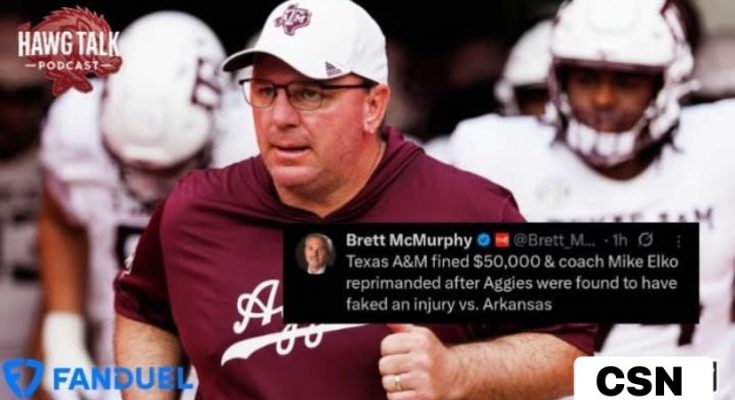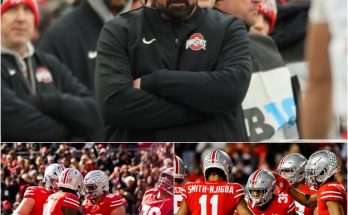Texas A&M University has found itself at the center of controversy once again after the Southeastern Conference (SEC) issued a $50,000 fine against the school, following an investigation that determined one of its players faked an injury during last weekend’s heated matchup against the Arkansas Razorbacks. The ruling has stirred debate across the college football landscape, raising questions about sportsmanship, coaching ethics, and the fine line between competitive strategy and outright deception.
The incident occurred midway through the third quarter of Texas A&M’s 31–24 win over Arkansas at AT&T Stadium in Arlington, a neutral-site venue that has hosted the rivalry for over a decade. With Arkansas driving and momentum beginning to shift, Aggies defensive lineman Marcus Hayes suddenly dropped to the turf clutching his leg after a completed pass. Play was halted for nearly a minute as trainers rushed onto the field, stopping the Razorbacks’ no-huddle offense and allowing Texas A&M’s defense to regroup. Moments later, Hayes jogged off the field under his own power and returned to action two plays later, looking perfectly fine.
At first, the moment appeared innocuous — after all, football is a physically demanding sport where players often cramp, tweak a muscle, or simply need a breather. But eagle-eyed fans and television commentators immediately began speculating that the injury was faked to disrupt Arkansas’s rhythm. Slow-motion replays and sideline camera angles appeared to show a coach signaling to Hayes before he went down, fueling accusations that the act was premeditated.
By Sunday morning, the SEC office had launched an internal review, analyzing game footage, sideline communications, and injury reports. Less than 48 hours later, the conference released its findings, declaring that Texas A&M had violated the league’s sportsmanship policy. The $50,000 fine was levied not just as a punishment for the isolated act but as a warning to all programs that such tactics will not be tolerated.
In its official statement, the SEC cited the importance of maintaining the integrity of competition, emphasizing that “any actions intended to deceive game officials or manipulate the natural flow of play constitute unsportsmanlike conduct and undermine the fairness of the sport.” The conference did not name the specific player or coach involved but stated that it had verified the incident as intentional.
Texas A&M head coach Mike Elko addressed the situation during his Monday press conference, appearing visibly frustrated but careful in his choice of words. “We take sportsmanship seriously here,” Elko said. “If a mistake was made, we’ll own up to it and make sure it doesn’t happen again. But I also want to be clear that no one on our staff instructs players to fake injuries. Football is an emotional, fast-paced game. Sometimes players cramp up or misread their body’s signals. We’ll review everything internally.”
Elko’s comments did little to quell the storm. Across social media, fans from rival schools pounced on the controversy, accusing the Aggies of stooping to gamesmanship that goes against the spirit of college football. Arkansas head coach Sam Pittman also weighed in subtly during his weekly media availability, saying, “I’ll let the league handle that stuff, but everyone saw what they saw. We want the game decided by players, not stoppages.”
The fine has reopened an old and uncomfortable debate within college football — one that has simmered for years without clear resolution. Faking injuries to slow down high-tempo offenses has become an open secret, particularly since the rise of spread systems that rely on pace and rhythm to tire out defenses. Coaches across the country have complained about it, yet no consistent enforcement mechanism has existed to deter it. The SEC’s decision to fine Texas A&M marks one of the few times a program has been officially punished for the practice, signaling that the conference may finally be ready to take stronger action.
The tactic itself, while unsightly, has long lived in a gray area. NCAA rules do not explicitly outline penalties for simulated injuries, largely because intent is nearly impossible to prove. Unlike clear infractions such as targeting or late hits, the motivation behind a player’s decision to go down is subjective and difficult to verify in real time. Officials cannot be expected to make medical judgments on the field, and erring on the side of player safety has always been the standard.
Still, the optics of the incident have placed Texas A&M under a harsh spotlight. The Aggies are a proud program with a rich history and passionate fan base, but they’ve also endured scrutiny in recent years for inconsistent results and controversial moments. This latest episode only adds to that narrative, portraying a team so desperate for a win that it resorted to questionable tactics.
For the SEC, the decision to fine the school sends a clear message to the rest of the conference. The league, home to some of the most competitive and lucrative football programs in the nation, prides itself on maintaining credibility and sportsmanship even amid fierce competition. By publicly disciplining Texas A&M, the SEC has effectively drawn a line in the sand — warning that teams caught engaging in similar behavior could face steeper penalties, including suspensions or loss of timeouts in future cases.
The response from the college football community has been divided. Some analysts praised the SEC for taking decisive action. ESPN commentator Paul Finebaum said on his radio show that “this was long overdue. Everyone knows this has been happening for years, and finally the conference is putting its foot down. You can’t just fall down every time a team starts moving fast and expect to get away with it.”
Others, however, questioned whether the fine would change anything meaningful. Critics argue that unless the NCAA or individual conferences adopt clear, enforceable rules for handling suspected fake injuries during games, the issue will persist. “A fine might sting the school’s pocketbook,” said former coach and analyst Gene Chizik, “but it doesn’t address the root of the problem. Coaches will still find creative ways to slow the game when they need to. Until officials are empowered to take on-field action, it’s all symbolic.”



